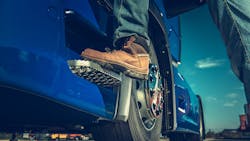At NACFE, we’ve long known the role drivers plays in the fuel efficiency of a commercial vehicles. When we developed Run on Less in 2017, we asked the participating fleets to select their best drivers because we know that it takes more than a properly spec’d truck to great fuel efficiency. We did the same thing in Run on Less Regional. Industry experts say that a driver can have as much as a 30% impact on fuel efficiency. The drivers in both Run on Less events demonstrated that a driver dedicated to fuel efficiency can make a big difference. In fact, the average MPG in Run on Less 2017 was 10.1 MPG and for Run on Less Regional it was 8.3 MPG—both numbers well above the national average.
That’s why I was excited when I saw the ATBS’ article, How To Drive Truck For Maximum Fuel Efficiency. It offered strategies drivers could employ to maximize fuel efficiency. They included many of the same things NACFE focuses on.
The first area the article focused on was speed—or rather reducing speed. I know some fuel-efficient drivers have been experimenting with driving faster to see if they can still put up good MPG numbers. The article reminded drivers that for every mile per hour over 60 mph fuel economy is reduced by one-tenth of a mile per gallon. The facts about speed and fuel efficiency allows drivers to understand the consequences of their decision to drive fast.
ATBS’s next suggestion was to find the most efficient RPM for your engine—aka the sweet spot—and stay there as much as possible. ATBS reminds us that, “If your engine is working harder in order to drive at a certain speed, more fuel is going to be used. According to the article, a good sweet spot is between 1250 and 1350 RPM.
Be careful with braking was another tip. While it is not possible to avoid all braking, every time you touch the brakes you lose energy. Keeping proper distance between your vehicle and the one in front of you is a good practice, as is paying attention to traffic flow and changes in traffic so you extend the distances between vehicles if needed.
If you are not using an automated transmission, minimize shifting. As the ATBS article says, “The gear you are in determines how much the engine is working. Remember, modern engines are built for high torque at low RPMs,” and “driving fast in a low gear consumes about 45% more fuel than is needed.”
The article also suggests a number of other things to do to improve MPG:
- Use cruise control: Cruise control helps maintain a consistent speed and can reduce fuel consumption up to 6%.
- Minimize idling: Idling not only wastes fuel it increases maintenance costs.
- Optimizing routing: Try to take the most direct route with the least number of stops to get to your destination. While many fleet drivers don't have control over their routing, owner-operators often do and therefore control off route miles.
Drivers can have a big impact on your fleet’s bottom line. Get them on board the fuel efficiency band wagon and watch your MPG numbers rise.
Michael Roeth has worked in the commercial vehicle industry for nearly 30 years, most recently as executive director of the North American Council for Freight Efficiency. He currently serves on the second National Academy of Sciences Committee on Technologies and Approaches for Reducing the Fuel Consumption of Medium and Heavy-Duty Vehicles and has held various positions in engineering, quality, sales and plant management with Navistar and Behr/Cummins.
About the Author

Michael Roeth
Executive Director
Michael Roeth is the executive director of the North American Council for Freight Efficiency. He serves on the second National Academy of Sciences Committee on Technologies and Approaches for Reducing the Fuel Consumption of Medium and Heavy-Duty Vehicles and has held various positions with Navistar and Behr/Cummins.
